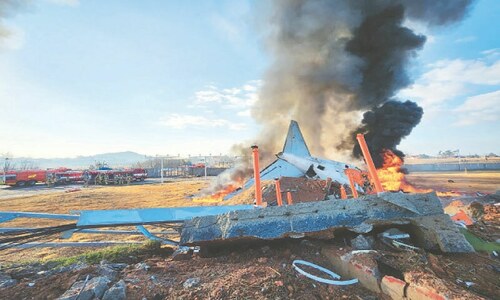KARACHI: The State Bank of Pakistan (SBP) announced on Friday that it has received the first tranche of $1.03 billion from the International Monetary Fund (IMF), as part of the approved $7 billion loan under the Extended Fund Facility.
This inflow will boost the country’s foreign exchange reserves, which stood at $9.53bn as of Sept 20, surpassing $10bn.
The SBP said in a statement that it has received the first tranche of 760 million SDR, or special drawing rights, equivalent to $1.027bn.
The central bank noted that these funds will be reflected in its liquid reserves, with an official update expected on Thursday (Oct 3).
IMF official says monetary and fiscal consistency, improving public spending main challenges for Pakistan
The government had been eagerly awaiting the IMF loan, with Prime Minister Shehbaz Sharif stating that his administration had met all the tough conditions required to secure the financing.
Finance Minister Muhammad Aurangzeb has repeatedly assured the nation that this $7bn loan will be the last financial assistance from the IMF.
The IMF executive board approved the 37-month Extended Fund Facility for Pakistan on Wednesday, following a staff-level agreement reached on July 12 this year.
The country was on the brink of sovereign default at the end of the fiscal year 2023 and the IMF’s $3bn Standby Arrangement played a crucial role in averting the crisis. The approval of this arrangement also helped Pakistan secure additional support from Saudi Arabia, the UAE and China, improving its foreign exchange reserves.
IMF Pakistan Mission Chief Nathan Porter declined on Thursday to provide details of additional financing amounts committed by the three countries, but said they would come on top of the debt rollover.
“I won’t go into the specifics, but UAE, China and the Kingdom of Saudi Arabia all provided significant financing assurances joined up in this programme,” he told reporters on a conference call.
Mr Porter said Pakistan has staged a “really remarkable” economic turnaround since mid-2023, with inflation down dramatically, stable exchange rates and foreign reserves that have more than doubled.
“So what we’ve seen is the benefits of undertaking good policies,” he said, adding that the challenge now was to build stronger and sustained growth by keeping monetary, fiscal and exchange rate policy consistent, raising more taxes and improving public spending.
Meanwhile, IMF Managing Director Kristalina Georgieva called her meeting with Prime Minister Shehbaz Sharif on Thursday “very productive”.
“We discussed Pakistan’s new Fund-supported program helping ongoing recovery, disinflation, increased tax fairness, and reforms to create new jobs and inclusive growth,” she said in a post on X.
According to SBP data, the country’s foreign exchange reserves peaked at $17.3bn in FY21 but plummeted to $9.8bn in FY22. Since then, the reserves have remained below double digits, reaching a low of $4.4bn in FY23.
Still, some financial experts describe the current increase in reserves as a “borrowed improvement”, yet they believe it will have a positive impact on market sentiment.
Experts predict that the exchange rate will remain stable, export proceeds will continue to flow into the country, foreign investors may gain more confidence in short-term bonds and importers will appreciate the stability of their businesses.
Bankers also suggest that the IMF tranche could encourage other lenders to extend credit or invest in Pakistan. Despite the country’s readiness to sell key assets such as Pakistan International Airlines to attract foreign investment, investors are still not ready to put their money into Pakistan.
Published in Dawn, September 28th, 2024















































Dear visitor, the comments section is undergoing an overhaul and will return soon.